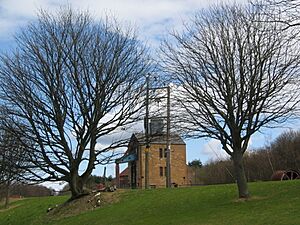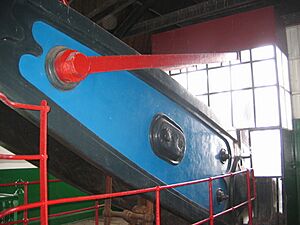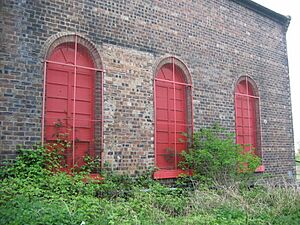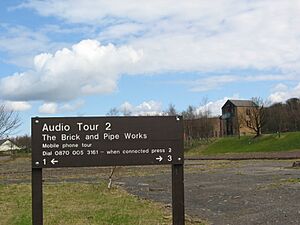Prestongrange Museum facts for kids
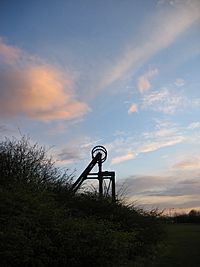
The colliery winding gear
|
|
| Established | 28 September 1984 |
|---|---|
| Location | 8 miles east of Edinburgh |
| Type | Industrial archaeology |
Prestongrange Museum is a cool place in East Lothian, Scotland, where you can explore the past of Scottish industry. It's located between the towns of Musselburgh and Prestonpans. This museum helps us understand how people used to work in factories and mines a long time ago. It was once the first home of the National Mining Museum, but since 1992, it has been looked after by the East Lothian Council Museum Service.
Contents
History of the Prestongrange Site
For hundreds of years, Prestongrange was a very busy industrial area. There was a harbour, a glass factory, a pottery, a coal mine, and a brick factory. All these activities left their mark on the land.
Early Coal Mining at Prestongrange
Monks from Newbattle Abbey were the first to dig for coal here, way back in the 1100s. This started a big coal mining industry. The last mine at Prestongrange had its first deep shaft dug in 1830. A special machine called a beam engine helped pump water out of the mine. This engine was updated in 1874 and could pump out over 2,900 litres of water every minute! The mine finally closed in 1963.
Prestongrange Today: A Place to Explore
Now, the Prestongrange site is a peaceful place surrounded by trees. You can see amazing views of the Firth of Forth. It's also a home for wildlife. Visitors can walk around and discover huge machines and old buildings from Scotland's industrial past. You can see the winding gear from the mine, the giant Cornish beam engine, and a huge brick kiln. There are also old coal wagons and a steam crane.
Some of the buildings here are very important. The pump house and its pump are listed as a Category A listed building, which means they are of national importance. The old power station and the Hoffmann kiln are also listed as Category B buildings.
How Prestongrange Museum Started
In the early 1960s, many coal mines in Scotland were closing down. People in the mining communities realized that a lot of important history and technology might be lost forever.
Prestongrange Colliery (the coal mine) closed in 1962. Work began to clear the site. But then, a new idea came up: turn the site into a museum! This idea came from David Spence, a retired mining engineer. A group was formed in 1968 to make it happen. Volunteers worked hard to clean up the site and gather old machines and tools. The National Mining Museum officially opened at Prestongrange on September 28, 1984.
Why Prestongrange Was a Great Museum Site
Prestongrange was a perfect spot for a museum for a few reasons:
- It's mentioned in some of the very first writings about coal mines in Scotland, dating back to the 1100s.
- The mine here had Scotland's first deep shaft, dug in 1830. It went down about 128 meters (420 feet)!
- It had the last Cornish beam engine still in its original place in Scotland.
Old items from around the coal mining areas were collected and stored at Prestongrange. The inside of the beam engine house and the power station became museum galleries.
Expanding the Museum's Focus
Later, another big mine, Lady Victoria Colliery, closed in 1981. The museum group decided to include that site too. From 1984 to 1992, Prestongrange and Lady Victoria worked together. Then, East Lothian District Council took over Prestongrange. They renamed it Prestongrange Industrial Heritage Museum. This new name showed that the museum would also cover other important industries that used to be in the area. These included making salt, chemicals, soap, glass, pottery, and bricks.
What You Can See at Prestongrange
When you visit Prestongrange Museum, you can explore many interesting features:
- The Hoffmann Kiln: This is a special type of oven used for making bricks.
- The Cornish engine: This is a unique type of steam engine and the only one of its kind left in Scotland.
- The winding engine: This machine was used to lower and raise miners and coal from the pit.
- The Power House: This building generated electricity for the mine.
- The 17th-century glass works: See where glass was made long ago.
- The 18th-century pottery site: Discover where clay pots were created.
- The 19th-century coal mine and brick works: Explore the old mine and brick-making areas.
- Morrison's Haven: This was a harbour from the 1500s.
- Old railway tracks and trains: See parts of the railway system that moved coal.
- The Visitor Centre: Here you'll find exhibitions and more information.
The Amazing Beam Engine
The beam engine at Prestongrange is a Cornish engine. It's an old type of steam engine that was used to pump water out of the coal mine. This stopped the mine from flooding. The engine was built in England and used in three different mines there. In 1874, it was bought by the Prestongrange Coal and Iron Company and brought to Scotland.
A new engine house was built for it. The front wall of this house is very thick, almost 2 meters (7 feet)! This strong wall was needed to hold the huge metal beam of the engine. The engine worked until 1954, when electric pumps took over. It's the only example of this type of engine still in its original place in Scotland.
Visitor Facilities and Events
You can take a self-guided tour of the museum using your mobile phone. The tour is narrated by the famous painter John Bellany, who was born nearby.
The museum is also a starting point for the yearly Three Harbours Festival. This festival is organized by the communities of Prestonpans, Prestongrange, Cockenzie, Port Seton, and other local areas.
The museum grounds are often used for other local events too. These include guided tours, plays, and re-enactments of the Battle of Prestonpans. The amazing Prestonpans Tapestry, finished in July 2010, might even find a home at Prestongrange someday.
See also
- Industrial archaeology
- European Route of Industrial Heritage (ERIH)
- List of places in East Lothian




